|
|
We're often reminded of the big lie that all the
Armenian men were killed (when most had crossed the border into Russia,
deserted from the Ottoman Army, or stayed behind to conduct a guerilla
campaign against their Ottoman nation), only to leave behind women, children
and old men, innocents who should not have been subjected to the relocation
(i.e., "genocide").
Naturally, most of these poor souls were innocent. Yet, by choice or coercion,
the majority were supportive of the revolutionary terrorists among them. The
entire community, belligerents de facto that had indignantly refused
to side with Turkey (as Boghos Nubar worded
it) had to be moved out of the war zone, or areas where the Armenians were
rebelling.
We have seen examples of Armenian women who even joined in violence, although
these were rare; mostly the womenfolk formed the support system in the
traitorous community, from feeding and clothing, to manufacturing bullets.
(Not all willingly, but what were they to do when these fanatical terrorists imposed their ways.) We have
also seen examples of how the elderly contributed to the Armenians' treacherous war
effort. But now let's focus on the Armenian children.
Let's keep in mind that most of the children were innocent. But more
than a few examples demonstrate Armenian kids had potential to be active
participants. Such examples will be tacked on to this page, in time.
We know from Leon Surmelian's
dream as an eight-year-old (as related in his "I Ask You, Ladies and
Gentlemen"), to run away and join the glamorous fedayis, that many
Armenian kids were moved by the idea. A lot of the young ones did exactly
that, mostly from the older age range (for example, Soghoman Tehlirian, the assassin of Talat Pasha,
ran away to join the Russians in 1914, at age 17. So did his brother, Missak.)
According to this internal army report, every Armenian over 13, based
on confessions by Armenians, were forced to enroll in Armenian
committees as functionaries or soldiers... in Van, Bitlis, Erzurum, Karahisar,
and second most important cities, Sivas, Kayseri, and Diyarbekir.
|
|
|
| Crack
Shot Brat |
"Peter Gragosian, a boy of 14, crept down through the brushwood and among the rocks.
He was so close he could hear the Turks talking. With five bullets he killed four
gunners."
From "Beat Off 4,000 Turks," The
New York Times, March 12, 1916.
|
Killer Kids
from 1895
|
"This brave population, who for a while had been forced to show restraint
voluntarily came to our call. A great number of Zeitunites came to join us in the
mountains where we had been hiding. . . . They had all come with arms; there were
even children who carried a knife or a gun."
Diary of Aghasi (Aghassi), leader of the 1895 Zeitun
rebellion, p. 189; as cited in The Armenian File.
|
| A
National Geographic Magazine Account |
The following article will be presented in its entirety. It
was written by Maynard Owen Williams, the famed photographer and foreign correspondent.
From this article (appearing in the August 1919 issue), it appears Williams had befriended
the Van governor, when the Armenian was living in Boston. Williams appears to have been a
Massachusetts resident, which would better explain his intense Armenophilia.
In another article of Williams on Armenia (from 1926), we are informed that "Maynard
Owen Williams took control of the relief efforts in the Lake Van area between December
1917 and February 1918. He embraced the country and fell in love with the people."
Obviously, he was more than a disinterested party regarding the Armenians to have taken
such an active role. Williams began his career at the magazine in 1919, and what's
below must have been one of his first contributions.
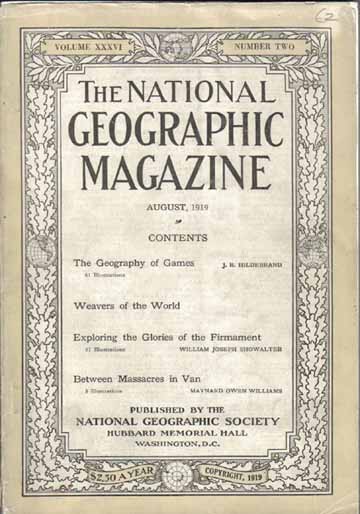
BETWEEN MASSACRES IN VAN
By MAYNARD OWEN WILLIAMS
The scene is Van, historic capital of Armenia, whose antiquity is proven by the
inscriptions of the conquering kings of many tribes carved in Castle Rock.
Tragedy is depicted in each ruined home, but the background is one of striking charm. To
the left, or southwest. there lies the majestic line of snow mountains which separate
Armenia from tile Tigris Valley.
Before us are the peculiarly lovely waters of the lake of Van, with Nimrud’s cratered
peak showing hazily forty miles away. A little to the north, one sees the graceful cone of
Sipan, where the ark of Noah first sought rest, only to have this hoary headed mountain
resign its fame to mightier Ararat, still farther north.
To the right—a ribbon of dark brown across the snow expanse—there runs the road of the
retreats, the way that leads to the Valley of the Shadow of Death.
My part has been building barracks out of fire-scarred mud shells, where once choice
carpets and silk hangings gave a touch of Oriental luxury to a city of beautiful homes and
green gardens. and providing work through which proud women could earn bread.
Through winter snows they came to petition the Armenian Governor for real guns with which
to defend their homes. The oldest of these boys was twelve. They were self-trained and set
out on their six-mile tramp without the permission or knowledge of their guardians in
Artemid.
In one huge house carpenters are fashioning windows and doors to make more habitable the
hovels where the people herd. And tons of matted wool are there being cleaned, carded, and
spun for clothing to protect weakened womanhood from piercing cold.
American charity is at work where misery is anesthetised by hope for future peace, where
barefoot children, trudging through the crunching snow, smile as they swing small
blackened pails in which they hope to get some watery soup to soften the black bread on
which their lives depend.
The Governor and I are closest friends. When he was young he ran an elevator in Boston and
learned his English from the kindly people whom he served. Now his is the task of
husbanding this pitiful group of Armenians until victory shall come to the Allied arms and
liberty to the land he loves.
|
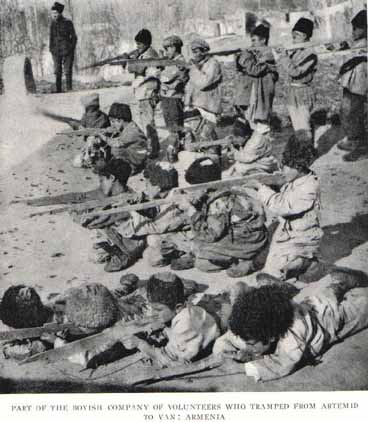
"Part of the Boyish Company of
Volunteers Who Tramped
from Artemid to Van; Armenia"
|
As we returned one day from our tasks to the modest mud house which was the which
was the humble home of government, we were confronted by a grotesque group of tiny
lads whose ages fan from eight to twelve.
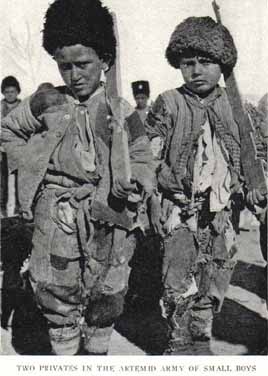 |
|
Two
Privates in the Artemid Army of Small Boys |
The Governor saluted the small, but dignified,
commander gravely and asked:
“What can the Governor do for these loyal citizens?”
“We have come to exchange these wooden guns which we have made for real guns. We
want to protect our country.”
“We have great need for all our guns, my men, said the Governor. “We only issue
rifles to those who can drill.”
The reply was immediate:
“We can drill, sir!’’ The busy man’s eyes twinkled a little at this delay,
but he said:
“Let me see what you can do.”
The 12-year-old leader gave a sharp command, and 28 wooden guns, carved from light
boards, came to the snowy street with a thud.
Up until they came again to “present arms,” back to “right shoulder arms,”
and then to “charge bayonets.” Not a smile showed on the youthful faces.
Then the untanned skin moccasins shuffled back and forth in fours and around to “company
front”— just such play at soldiering as makes us smile proudly, but with a
little catch at the throat, whenever we see this youthful imitation of a world at
war.
But most of these small lads had a murdered father or a suicide mother,
hounded to her death by Kurdish fiends, as his background.
The Governor was deeply moved. “Where are your homes?” he asked, expecting that
they came from some near section of the city.
“We come from Artemid, sir!‘‘ was the challenging reply. mentioning a lakeside
village six miles distant on the road to the Turkish lines.
|
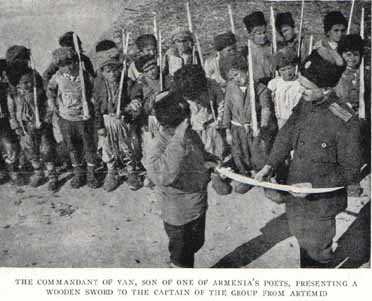
"The Commandant of Van, Son of One
of Armenia’s Poets,
Presenting a Wooden Sword to the Captain of the Group from Artemid." |
The day before there had been a heavy snow and the afternoon shadows were already
lengthening. Even a strong man would have difficulty in reaching Artemid that night.
So Governor Hambartsoumiantz called in the youthful commandant and myself to a
council, which resulted in the issue of an army ration of black bread, tea, and
sugar to the boys, while a room was provided for them in the headquarters of the
city troops. Still the lads said they would not return to their homes unless they
were given guns.
Relief work is not a matter of stomachs alone, but of morale. So in the morning my
head carpenter set to work on the choicest board we could find, and while he was
fashioning it into a blade with all the curves of Saladin’s sword, the boyish
company inspected the varied industries.. which American relief had established, and
each received a pair of heavy woolen socks.
Then the lads drew up at attention on the flat mud roof of our premises.
There the young commandant, son of one of Armenia’s famous poets, gracefully
presented the 12-year-old captain with a saber, whose wooden fabric could not
conceal the lines which were smilingly, yet tearfully, worked into it by the master
carpenter, who entered with all his heart into this simple commission of love.
“This time we can only give your leader a sword,” said the Governor, who had
left an important conference to wish these lads farewell.
“But I wish you to keep up your discipline and training, for the time may come
when we shall need your aid. Hold your command in readiness Captain, for your
country may call on you.”
“We shall be ready, sir!” said the proud possessor of the new sword.
Then he turned to his motley gang:
“Right shoulder arms! Column right, march!” And the volunteer army of Artemid
started proudly on their long tramp to the village through which, a month later, the
Turkish hordes passed on their way to massacre in Van.
Holdwater Reflects
"The Turkish hordes." Apparently, Turks were not even in the human
category for this awful bigot.
(Nor, for that matter, were the Kurds, whom Williams regarded as "fiends."
While history accounts for the murderousness of Kurds — many of the massacred
Armenians died in the hands of Kurds — no peep from him as to the greater number
of Kurds that the Armenians had slaughtered.)
Interestingly, we are first told that the boys "were self-trained and
set out on their six-mile tramp without the permission or knowledge of their
guardians in Artemid," and next we are told most were without parents.
Anything to tug at our heartstrings in this extremely romanticized telling, the
facts for which Williams needed to rely entirely upon the translations of his
Armenian friends. (Don't you love the way Williams keeps referring to these kids as
though they were a real army, "captain" and all?)
While these children were thankfully not allowed to join the ranks of actual
soldiers, the article demonstrates the burning desire fed into Armenian male youth
to kill. For example, in an example
of "Armenian oral history," as soon as a son is born, grandpa shows signs
that the infant should be weaned to kill. ("...[M]y grandfather put the
sword beside me, saying: 'Let him be a fedayi.'")
(Is it any wonder there was little shortage of Armenian terrorists who went on their terribly murderous spree between
1973-1987? The glamorization of the "fedayi" is embedded in Armenian
culture.)
Around a year before this article appeared, Avetis Aharonian wrote in a
Sept. 9, 1918 telegram to Prime Minister Hovhannes Katchaznouni: "...[T]he
Armenian nation would never forget that it was the Ottoman Government which first
conceived the idea of founding an independent Armenia, and recognized it." Now this was the Ottoman
government accused of trying to exterminate the Armenians. And the government that
replaced the CUP regime was a practical non-entity in 1919, devastated and occupied
by the Allies. So I wonder who these hostile "Turkish hordes" were, on
their way to "massacre" these poor, defenseless Armenians? (Ataturk's
forces would not come into play against the Armenians until the following year.)
While this variety of reportage was the norm, its racism is no less repugnant...
particularly from a publication that should have known better. (National
Geographic is ideally perceived as apolitical in nature. These days, perhaps
because an Armenian sits in their editorial board, the magazine has become yet
another mouthpiece for propaganda, when articles about Armenia are featured.) While
the Armenians were occupying eastern Anatolia, they were committing frightful acts
of massive ethnic cleansing,
against defenseless Turks and other Muslims. If Williams was hanging out with these
Armenians, he could not have avoided witnessing signs of Armenian criminality.
(Didn't he wonder what happened to the Turks of Van, an Ottoman possession for
centuries, regardless of how much Williams insists that Van was the "capital of
Armenia"?) Yet he must have been so prejudiced, he ignored the plight of the
Turks completely, and did his best to force his fellow Americans' tears for the
Armenians.
(With thanks to reader M. Mersinoglu.)
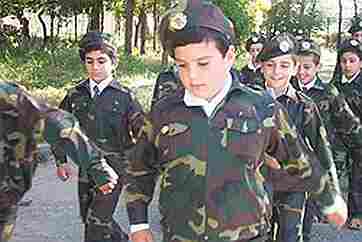
The proud tradition continues today; 11-12 year-old children from Yerevan undergoing
military training. “We learn how to crawl round enemies and kill them,” beamed
Sarkis, 11. His grandmother said parents had heartily welcomed the scheme. The
school’s military instructor says it is best to start as young as possible: “A
child is like unbaked dough, and you should teach them things from a very early
age.” Read "Armenian Pupils March to New Step." (Thanks to
Gokalp.)
|
| A Small Army of
Deadly Juveniles |
Hostilities began April 20 at dawn. Rifle and cannon fire was
opened from five strong positions on the old town or business center and on the Armenian
residence quarter, called the Gardens, as every house is partly surrounded by vineyards
and orchards. By evening houses were on fire in all directions. Fifteen Armenian riflemen,
reinforced at times by 1,500 youths armed with pistols or hand grenades, manned
eighty barricaded houses, connected by trenches and mud walls.
"City of Van Free of Turks at Last," Dallas News, July 14, 1915
|
|